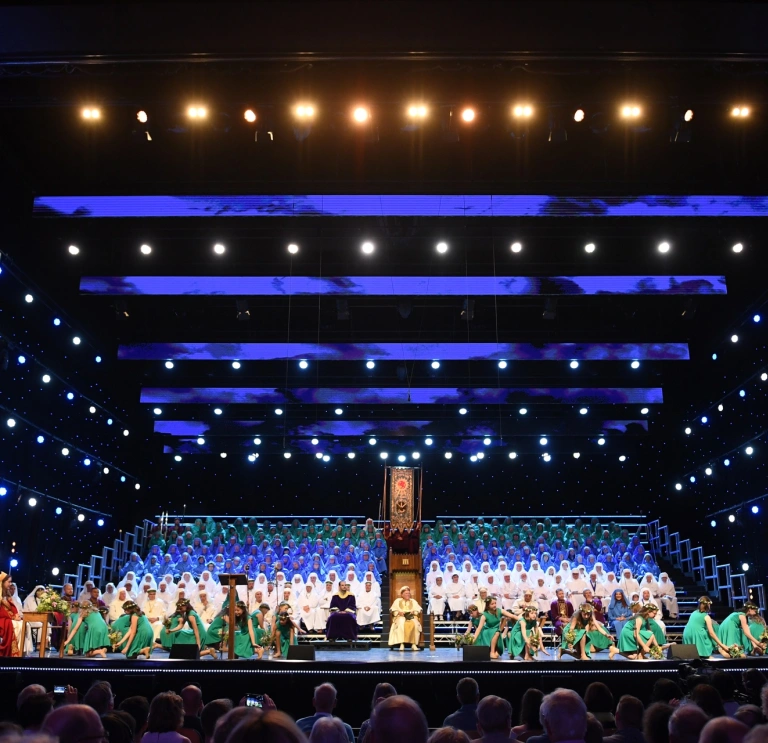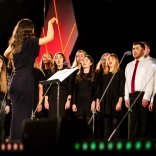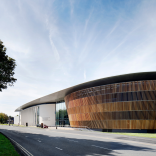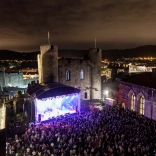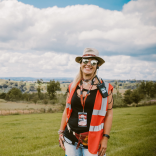Attracting up to 170,000 visitors every year, the National Eisteddfod is the largest cultural festival in Europe.
The event is a week-long, moveable feast of Welsh culture that travels the mountains and valleys of Wales and brings a celebration of all things Cymraeg – both old and new – to people across the land.
The early days of eisteddfodau
The word eisteddfod means “sitting together” or “gathering”, and eisteddfodau are cultural gatherings of all sizes, usually conducted in the Welsh language, involving a variety of contests and performances.
In medieval Wales, the skills of the bard or poet were much revered. Informal competitive events were often held for apprentice poets and musicians to seek seats of honour in noble households. In 1176 in Cardigan, Lord Rhys ap Gruffydd held a grand Christmastide gathering of poets and musicians following this format – widely considered to be the first eisteddfod.
Though times have changed, the concept has endured, and today people still “sit together” at annual eisteddfodau of varying sizes, from local community events to huge festivals like the National Eisteddfod. No matter the scale, all eisteddfodau events continue to hold great cultural importance in Wales.


The big one
The National Eisteddfod is the largest eisteddfod held in Wales, and takes place during the first week of August every year, alternating between locations in the north and south of the country. The focus at the National event is on demonstrating artistic skill through competition. Poets, musicians, artists and dancers compete for prizes while entertaining the crowds.
The event is steeped in tradition. One of the oldest and most colourful spectacles is the Gorsedd Cymru ceremonies. Under the leadership of the Archdruid, top award-winners are revealed, while druids dressed in white, blue, or green robes (indicative of their various ranks) look on. The winners are honoured with a range of performances, including a floral dance performed by local children. It’s as fabulously far-out as it sounds.
Although the National Eisteddfod is primarily focused on adult competition, there are plenty of youth events as well. But where do the winners of tomorrow hone their craft? The concept of the eisteddfod is woven into the Welsh education system, where children as young as four will start “competing” in the classroom. Young people who enjoy the competition can participate in the Urdd Eisteddfod, the National’s counterpart for younger competitors, with over 15,000 competing each year.

A 21st-century festival
Though it may all sound a little old-worldly upon first impressions, the National has developed into a multidimensional event; celebrating contemporary Wales as well as upholding historical convention.
Along with the age-old competitions for poetry and dance, there are now categories for spoken word, literature writing, essays, short stories, humorous performances, and much more. The festival element has also grown significantly in recent years, with glitter featuring almost as prominently as the Gorsedd. Consequently, visitors will find an impressive array of cafes, bars, artisan stalls and street food vendors on site to rival any of Wales’ major summer festivals.
A programme of events is also held to celebrate our wonderful and diverse audiences. The Mas ar y Maes partnership (between Stonewall Cymru and the Eisteddfod) was created to celebrate the LGBTQ+ community, and has added an element of the fabulous to proceedings. Recent highlights include Parti Pinc: This is Ballroom presented by the Welsh Ballroom Community, and Qwerin – a queer take on folk dancing.
For younger people, Maes B is the after-dark little brother of the Eisteddfod. A stone’s throw from the main site, the best Welsh pop, rock, indie and hip hop bands and DJs perform until late into the night (or early morning). This is the pinnacle performance for many Welsh bands, and for many young people, this will be their first experience of live music and late-night festival fun — hwyl a sbri!

